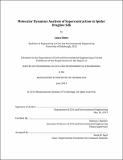| dc.contributor.advisor | Markus J. Buehler. | en_US |
| dc.contributor.author | Batty, Laura | en_US |
| dc.contributor.other | Massachusetts Institute of Technology. Department of Civil and Environmental Engineering. | en_US |
| dc.date.accessioned | 2013-12-06T19:50:33Z | |
| dc.date.available | 2013-12-06T19:50:33Z | |
| dc.date.copyright | 2013 | en_US |
| dc.date.issued | 2013 | en_US |
| dc.identifier.uri | http://hdl.handle.net/1721.1/82707 | |
| dc.description | Thesis (M. Eng.)--Massachusetts Institute of Technology, Dept. of Civil and Environmental Engineering, 2013. | en_US |
| dc.description | This electronic version was submitted by the student author. The certified thesis is available in the Institute Archives and Special Collections. | en_US |
| dc.description | Cataloged from student-submitted PDF version of thesis. | en_US |
| dc.description | Includes bibliographical references (p. 67-73). | en_US |
| dc.description.abstract | Spider dragline silk is a material that has evolved over millions of years to develop finely tuned mechanical properties. It is a protein-based fiber, used as the main structural component in spider webs and as a lifeline for the spider, and it combines strength and extensibility to give it toughness currently unmatched by synthetic materials. Dragline silk has the unusual tendency of shrinking by up to 50% when exposed to high humidity, a phenomenon called supercontraction. Supercontraction is thought to occur due to the association of water molecules with the amorphous region of silk proteins. The water molecules are believed to break the hydrogen bonds that connect the protein strands, causing a fundamental reorganization of molecular structure, which is manifested at the macro scale by a large retraction in length. However, the details of these mechanisms remain unknown and have not been directly demonstrated in prior research. Here we use full-scale atomic modeling of spider silk using molecular dynamics to investigate the structure and properties of this material at a length scale that is not yet accessible by experimental methods. A model of spider silk protein is used to explore the phenomenon of supercontraction. Two classes of simulations with different models are performed, and in both cases the models show a reorganization of the molecular structure consistent with the theory of supercontraction, yet fail to show the dramatic change in size that is observed on the macro scale. | en_US |
| dc.description.statementofresponsibility | by Laura Batty. | en_US |
| dc.format.extent | 84 p. | en_US |
| dc.language.iso | eng | en_US |
| dc.publisher | Massachusetts Institute of Technology | en_US |
| dc.rights | M.I.T. theses are protected by
copyright. They may be viewed from this source for any purpose, but
reproduction or distribution in any format is prohibited without written
permission. See provided URL for inquiries about permission. | en_US |
| dc.rights.uri | http://dspace.mit.edu/handle/1721.1/7582 | en_US |
| dc.subject | Civil and Environmental Engineering. | en_US |
| dc.title | Molecular dynamics analysis of supercontraction in spider dragline silk | en_US |
| dc.type | Thesis | en_US |
| dc.description.degree | M.Eng. | en_US |
| dc.contributor.department | Massachusetts Institute of Technology. Department of Civil and Environmental Engineering | |
| dc.identifier.oclc | 862116152 | en_US |
